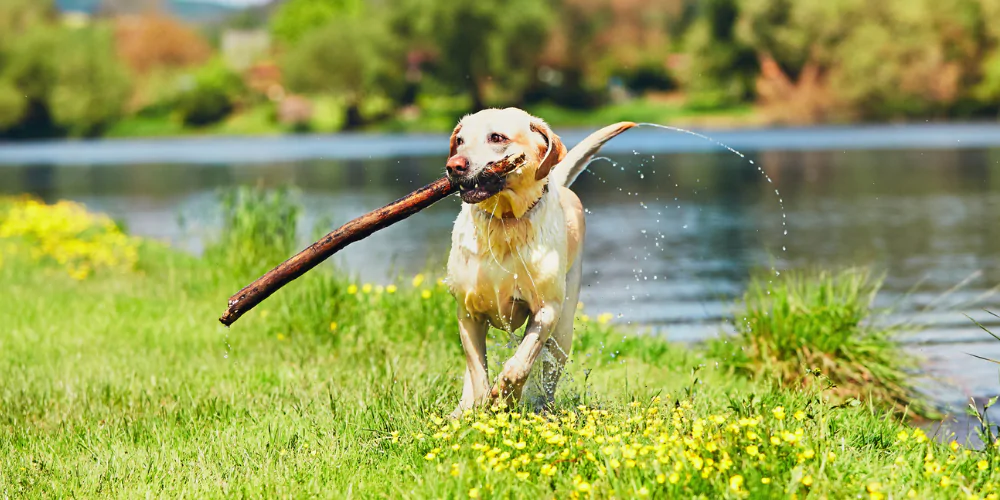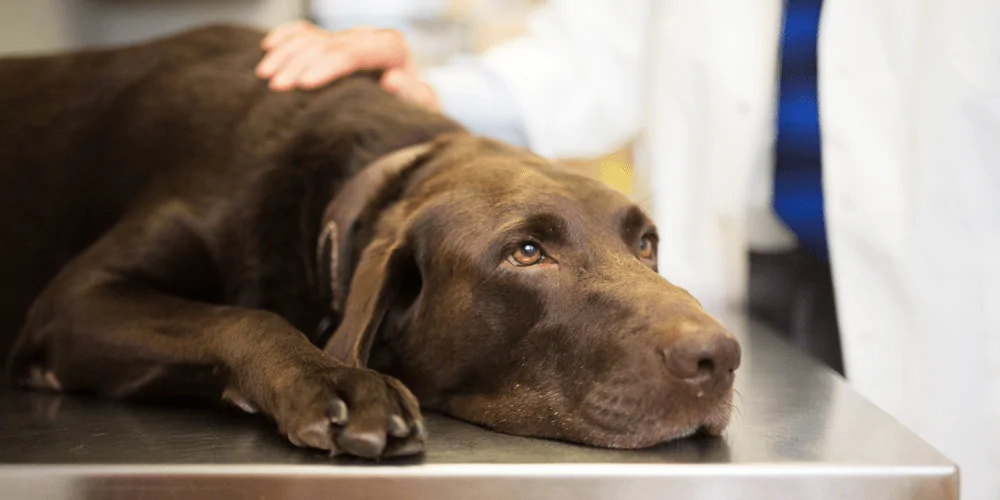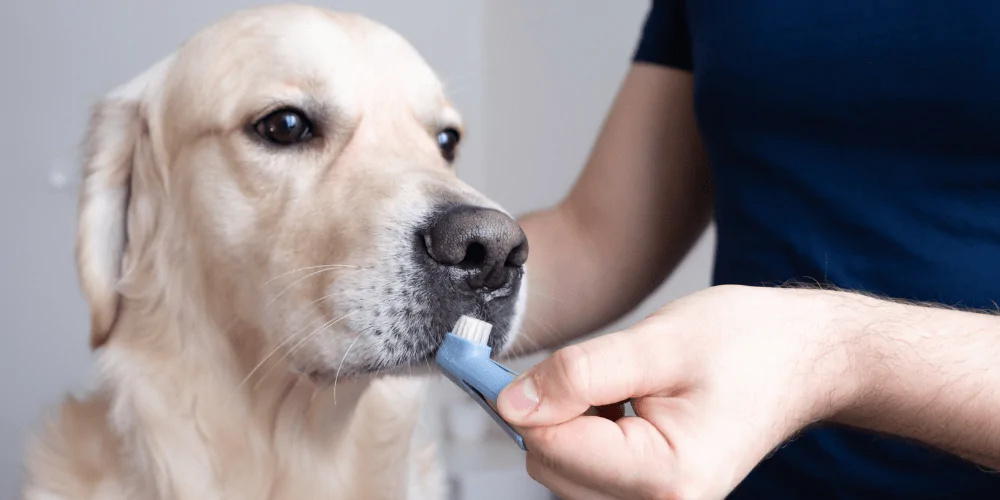Covers your pet up to the chosen vet fee limit if they have a dental accident or injury. Always be sure to take your pet for annual dental check-ups, and follow your vet’s advice.
One of the UK’s favourite dogs, the friendly, sociable Labrador is the ideal family companion. Gentle and tolerant, they’re eminently trainable, full of energy and love to play. They can be prone to obesity thanks to genetic factors and an insatiable appetite, which can exacerbate health issues, so go easy on the treats.


A guide to owning a Labrador
The Labrador Retriever is one of the most popular dog breeds in the UK – and we can see why. With their friendly temperament, intelligence and unwavering enthusiasm, Labradors make excellent family pets.
As with all breeds, it’s best to do some research before committing to a Lab, as they do need plenty of exercise and training. Here we look at what you need to know, such as their common health issues, temperament, exercise and grooming needs.
Are Labradors good family dogs?
They’re great family dogs! They’re affectionate and friendly, while also being patient and tolerant. The ideal combo really. This makes them great with kids and other pets, although they can be a bit of a whirlwind, especially during puppyhood and adolescence. Due to their high energy levels and boisterous streak, training is essential to keep their natural exuberance in check.


Labrador size and appearance
Labradors are athletic dogs with a sturdy build and friendly face. They have a broad head, mid-length muzzle and kind eyes. They also have an ‘otter tail’ – thick at the base and tapering to a point – which helps them swim. Male Labs are around 56-61cm tall at the shoulder, weighing 29-36kg. Females are slightly smaller, standing at 53-58cm at the shoulder, and weighing in at 25-32kg.
They have a short, dense double coat which is water-resistant. These generally come in three colours, although there are a couple of less common colours too:
- Black
- Yellow
- Liver / chocolate
- Fox red
- Silver (rare)
What were Labradors bred for?
Originally bred in Newfoundland to assist fishermen, later developed in the UK for retrieving game, the modern Lab is both a loyal companion and dependable working dog.


What is a Labrador’s temperament?
The Labrador’s personality is:
- Social butterfly: Labs are naturally outgoing, enjoying the company of people and other animals.
- Gentle souls: They’re gentle and patient once grown, especially with children and the elderly.
- Eager to please: They co-operate well, which makes them a joy to train.
- Full of energy: Labradors love to play, fetch and stay active throughout the day. They can be a little boisterous for younger children or low-energy pets, especially when still growing up.
- Loyal and affectionate: They form strong bonds with their families, and love attention and companionship.
Can Labradors be left alone?
Labradors love companionship, so they’re not great at being left alone for too long. You can train them to be by themselves for a couple of hours, but anything more risks separation anxiety and unwanted behaviours.
Bear in mind that no dog should be left for longer than four hours. If you do need to leave your Lab alone for any length of time, make sure they have access to fresh water, plus familiar and comforting items like their favourite toys and blankets.


How much exercise does a Labrador need?
Labradors are a high-energy breed, needing plenty of daily exercise to keep them happy and healthy. Lab owners need to be dedicated to daily activity, with a combination of walks, off-lead play, swimming and games like fetch. If they’re well exercised, they’ll be calm and content while at home.
If these needs aren’t met, Labradors can become bored and destructive. They’re also very smart, so it’s crucial to exercise their grey matter too. You can keep them entertained with things like puzzle toys and scent games, and also through training sessions.
Can Labradors swim?
Absolutely! Generally speaking, Labs love the water. Being bred to retrieve waterfowl, they’ve developed physical features such as webbed paws and a water-resistant coat, which are great for swimming.
It’s worth remembering that all dogs are individuals, so don’t assume they’ll be hugely confident in water the first time. They may need a little getting used to it, so make sure they’re closely supervised to begin with.


Our expert says…
Labradors are eternally popular for good reason. Their friendly, easily trained nature makes them ideal family pets.
The biggest issue I see in this breed is obesity, as all Labradors come pre-programmed to easily put on weight (something now proved with genetics), and their desire to eat anything and everything doesn’t help with this! Obesity also exacerbates the main inherited condition vets see in the breed – hip and elbow dysplasia. In dysplastic conditions the joint develops abnormally as the dog grows, causing painful early onset osteoarthritis that can only be managed rather than cured.
Make sure your puppy comes from a reputable breeder who can prove low hip and elbow scores for both parents. Then ensure you feed a good quality, large-breed complete diet that allows for slow growth and a healthy weight.
Dr Siân Burwood MA VetMB MRCVS


How long do Labradors live?
The average lifespan of a Labrador is around 10-14 years.
What are the common health issues for a Labrador?
Labradors generally live between around 10 to 14 years. But like all breeds, they are prone to certain health issues, including hip and elbow dysplasia, obesity and ear infections.
Make sure they get regular check-ups at the vet, plus a balanced large breed diet. Maintaining a healthy weight is really important in preventing many common problems. Labs love food (who doesn’t?), but this means they’re often given to overeating. Keep on top of this with portion control, and limit those treats.
Top 3 pet insurance claims for Labradors
These are the three conditions most commonly claimed for, according to Petgevity data:
- Leptospirosis (blood infection)
- Growth or tumour
- Gastroenteritis (inflammation of stomach and intestines)
Based on Petgevity pet insurance claims, 1 Jan to 31 Dec 2024.


Labrador grooming and hygiene
Labradors have a short, dense double coat. In spite of shedding regularly, they’re relatively low-maintenance when it comes to grooming. You do need to clean their ears and trim their nails regularly though, as well as keeping up with their dental care.
Being natural swimmers, Labs also love water. Be sure to dry them thoroughly after a swim to prevent ear infections or skin issues, washing beforehand if they’re dirty.
Do Labradors shed?
Yes. Their double coat sheds throughout the year, with heavier shedding in spring and autumn. Weekly brushing helps control loose hair, keeping their coat in good condition.
Are Labradors hypoallergenic?
No. Well, no one’s perfect. One of the downsides of Labs is that their double coat sheds a lot, especially when the seasons change. This can affect those who are sensitive to allergies. It’s also worth noting that no dog breed is truly hypoallergenic.


How to train a Labrador
Here’s some good news: Labradors are one of the most trainable dog breeds, thanks to their intelligence and strong desire to please. Reliability and responsiveness to training are part of the reason they’re often used as assistance dogs.
Here are a few pointers to help get the best out of their training:
- Begin training and socialisation from puppyhood to help build good behaviour and confidence.
- Positive reinforcement is the way forward. Labradors respond best to treats, praise and play-based rewards. Just don’t overdo the treats…
- Be consistent, sticking to clear commands and routines. This’ll help your Lab learn quickly.
- To maintain focus and enthusiasm, keep training sessions short and engaging.


What insurance do I need for my Labrador?
The level of dog insurance you choose for your Labrador will generally be down to your circumstances and budget. To find out what you’re getting for your money, read our guide to whether pet insurance is worth it.
We think that all dogs deserve the most comprehensive level of cover as possible. This is why we only sell different types of lifetime cover. We could also cover your Labrador for any pre-existing conditions they may have with our Lifetime Plus policy, subject to acceptance*.


Guides and advice from experts
Our expert vets and behaviourists have great pointers to help keep your pet happy and healthy.

If your dog gets ill or has an accident, you want to give them the best care possible. Let’s take a look at why having pet insurance is important for your pooch.

How to choose the best pet insurance for my pet
We explain the top things you may want to think about when it comes to researching pet insurance policies, including how you can compare pet insurance.

What is lifetime pet insurance?
We’re saying farewell to all of the confusion around lifetime pet insurance. Join us as we explore what it is and how it works.
What’s included in your dog cover
Choosing Petgevity to protect your dog gives you more than just vet fee cover. Here's what you get from our policy.
Dental accident
Covers your pet up to the chosen vet fee limit if they have a dental accident or injury. Always be sure to take your pet for annual dental check-ups, and follow your vet’s advice.
More info
Covers your pet up to the chosen vet fee limit if they have a dental accident or injury. Always be sure to take your pet for annual dental check-ups, and follow your vet’s advice.
Behavioural treatment
Get expert help with your pet’s mental and emotional wellbeing, as advised by your vet. Cover up to your chosen vet fee amount or the cost of up to 12 sessions, whichever is lower (Lifetime Plus); or up to £1,000 (Lifetime).
More info
Get expert help with your pet’s mental and emotional wellbeing, as advised by your vet. Cover up to your chosen vet fee amount or the cost of up to 12 sessions, whichever is lower (Lifetime Plus); or up to £1,000 (Lifetime).
Complementary therapy
As advised by your vet, this covers alternative treatments like acupuncture or hydrotherapy. Cover up to your chosen vet fee amount (Lifetime Plus); or up to chosen vet fee amount or £1,500, whichever is lower (Lifetime).
More info
As advised by your vet, this covers alternative treatments like acupuncture or hydrotherapy. Cover up to your chosen vet fee amount (Lifetime Plus); or up to chosen vet fee amount or £1,500, whichever is lower (Lifetime).
Emergency care
If you can’t look after your pet due to an emergency, such as an unplanned hospital visit, this covers you for up to £1,500 (Lifetime Plus) in minding costs.
More info
If you can’t look after your pet due to an emergency, such as an unplanned hospital visit, this covers you for up to £1,500 (Lifetime Plus) in minding costs.
Third-party liability for dogs
Covers you for legal costs if your dog causes injury to somebody or their pet, or causes loss or damage to someone’s property. Protects you for up to £2 million in a legal action.
More info
Covers you for legal costs if your dog causes injury to somebody or their pet, or causes loss or damage to someone’s property. Protects you for up to £2 million in a legal action.
Choice of optional extras
Need extra protection? Choose from several optional extras to cover your pet’s needs, including dental illness, or cover if your pet is stolen or lost.
More info
Need extra protection? Choose from several optional extras to cover your pet’s needs, including dental illness, or cover if your pet is stolen or lost.
Dental accident
More infoBehavioural treatment
More infoGet expert help with your pet’s mental and emotional wellbeing, as advised by your vet. Cover up to your chosen vet fee amount or the cost of up to 12 sessions, whichever is lower (Lifetime Plus); or up to £1,000 (Lifetime).
Complementary therapy
More infoAs advised by your vet, this covers alternative treatments like acupuncture or hydrotherapy. Cover up to your chosen vet fee amount (Lifetime Plus); or up to chosen vet fee amount or £1,500, whichever is lower (Lifetime).
Emergency care
More infoIf you can’t look after your pet due to an emergency, such as an unplanned hospital visit, this covers you for up to £1,500 (Lifetime Plus) in minding costs.
Third-party liability for dogs
More infoCovers you for legal costs if your dog causes injury to somebody or their pet, or causes loss or damage to someone’s property. Protects you for up to £2 million in a legal action.
Choice of optional extras
More infoNeed extra protection? Choose from several optional extras to cover your pet’s needs, including dental illness, or cover if your pet is stolen or lost.
*Cover for pre-existing medical conditions is subject to acceptance. They will not be covered unless you have declared them and they are shown on your Confirmation of Cover.

